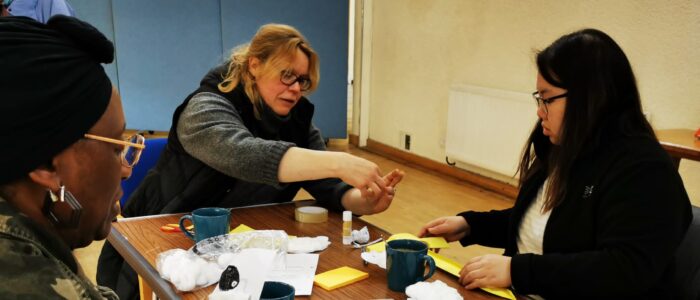When the shoe doesn’t appear to fit…

Recently, myself and a FaithAction colleague went to a National Summit on Wellbeing and Mental Health, looking at Public Health England and how mental health is being prioritised in the new public health system.
At first, we felt like the odd ones out in a large room of academics, mental health ‘experts’ and representative from mental health charities. As an organisation supporting faith-based social action, when we participate in health events, we often sit outside of the box, and it takes a bit of thinking to figure out how we ‘fit’.
However, nine times out of ten, the work done by our members does fit… and this event was no exception.
At any one time, faith groups will be addressing a huge range of issues within their communities, relating to a number of health issues ranging from projects to reduce isolation, to reduce avoidable mortality, to care for the health of children, and many more. The problem is that this work is not packaged in a way that those outside the faith sphere can easily assess its impact. Indeed, the impact is often unmeasured within faith communities, where the aim is simply to meet the need!
This makes it difficult to marry the two worlds of health and faith.
During this conference, I heard phrases like ‘building social capital’ and ‘supporting mental wellbeing’, which are the very basic functions that the majority of faith-based projects will provide to those who walk through their doors.
When those in the health sphere talk about ‘services’ that promote wellbeing in a community, a faith group may automatically discount the mother and toddler session which takes place on a Wednesday morning… but this is exactly the type of project which plays a vital part in the everyday promotion of wellbeing and the creation of support networks. Faith groups need to take stock of their impact within the community and consider that they are an important part of the public health narrative; a conversation which is slowly turning from simply ‘the prevention of illnesses’ to the promotion of wellbeing.
Public Health England, too, has a role to play in shaping the language that is used around health and wellbeing in order to open up the conversation and ensure that the voices of ‘the community’ are heard, and that this is demonstrated in the evidence which informs decision making.
If you would like to learn more about how to measure the impact of your projects on mental health, take a look at the following tools:
- The Warwick Edinburgh Mental Well-Being Scale (WEMWBS) is a free tool to measure mental wellbeing. It was developed by mental health experts at Edinburgh and Warwick University, in the form of a simple 14-question questionnaire. A shorter 7-question version is also available. It has been widely used and promoted by scientists and psychologists, including NHS England and NHS Scotland.
- Mind’s resources on resilient communities includes a practical guide for community groups on how to make mental health a day-to-day consideration in your activities, and a PowerPoint for staff or volunteers.
- If you are part of a faith group looking to improve support for mental wellbeing in your community, take a look at FaithAction’s Friendly Places campaign, where you can find articles tips and resources, and sign our Friendly Places Pledge!


